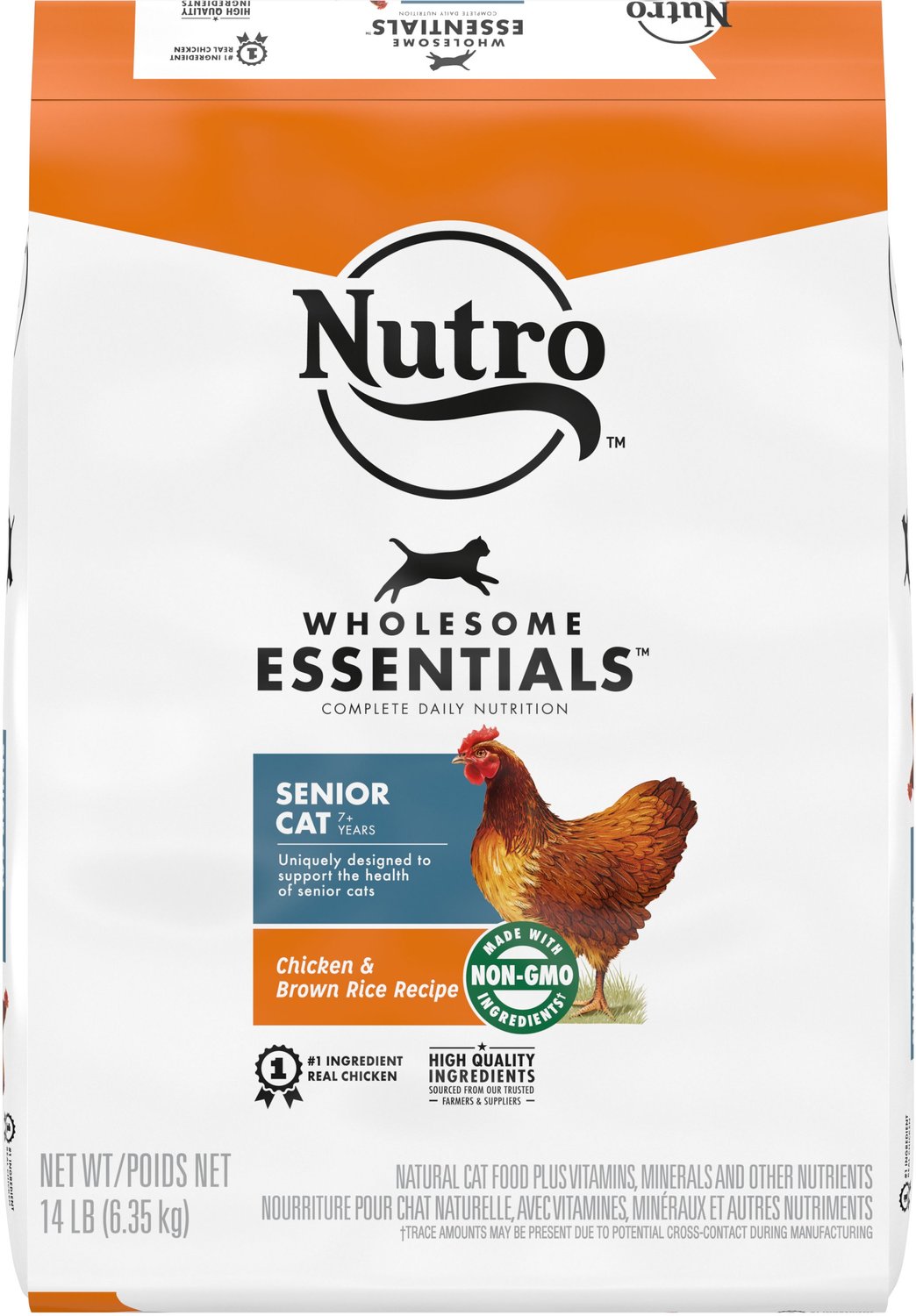Himalayan
Felis catus
When you cross a Persian feline and a Siamese feline, you get the beautiful Himalayan.
Advertisement
Himalayan Scientific Classification
- Kingdom
- Animalia
- Phylum
- Chordata
- Class
- Mammalia
- Order
- Carnivora
- Family
- Felidae
- Genus
- Felis
- Scientific Name
- Felis catus
Read our Complete Guide to Classification of Animals.
Himalayan Conservation Status
Himalayan Facts
- Fun Fact
- When you cross a Persian feline and a Siamese feline, you get the beautiful Himalayan.
- Other Name(s)
- Himalayan Persian, Colorpoint Persian, or Himmy
- Temperament
- Easy-going, calm and playful
- Diet
- Omnivore
- Average Litter Size
- 4
Himalayan Physical Characteristics
- Color
- Fawn
- Blue
- White
- Cream
- Chocolate
- Skin Type
- Hair
- Lifespan
- 9-15 years
- Weight
- 7-12 pounds
- Age of Sexual Maturity
- 5-7 months (male), 6-12 months (female)
This post may contain affiliate links to our partners like Chewy, Amazon, and others. Purchasing through these helps us further the A-Z Animals mission to educate about the world's species.
View all of the Himalayan images!
When you cross a Persian feline and a Siamese feline, you get the beautiful Himalayan. These animals with their solid-colored bodies look like they are wearing a mask because of their points. Himalayan cats are loving family animals that adore being the center of attention.
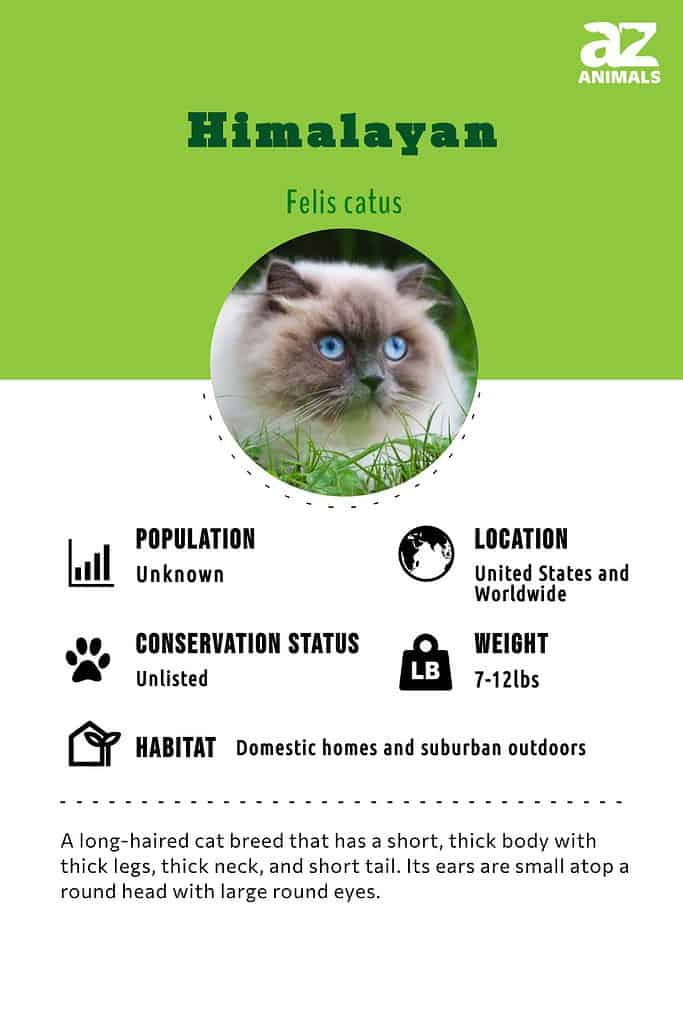
Breed History
The Himalayan breed is a sub-breed of the long-haired Persian. It has specific features such as its blue eyes and point coloration derived from crossing the Persian with the Siamese breed. The Cat Fanciers’ Association classifies the Himalayan as a color variation of the Persian instead of its own sub-breed. The name is a reference to Himalayan animals like the Himalayan rabbit, which have specific colorations.
See all of our expert product reviews.
In the United States, the cross-breeding of Persians with Siamese to produce Himalayans began at Harvard University in the 1930s, but without officially registering them. The same cross-breeding experiments occurred in the UK, resulting in the Longhaired Colourpoint breed being recognized in 1955 by the GCCF.
It wasn’t until 1948 that a few breeders in the US made more concentrated efforts at crossing Siamese and Persian cats, such as California cat breeder Jean Mill, and Mrs. Goforth, who helped the new Himalayan breed gain recognition by the Cat Fancier’ Association in 1957. The new breed developed over the next few decades, evolving into a cat that is less Siamese-like.
Traits: What to Know Before You Buy
Before you buy a Himalayan, there are several factors, you should keep in mind:
- Himalayan cats are big cats that should have a large bone structure. They should be equally massive across the shoulders and the rump. The Himalayan should not be fat, but it should have the bone structure to carry its weight
- The first efforts to breed a Himalayan-type cat were by Virginia Cobb and Dr. Clyde Keeler in the 1930s, and the result was a Newton’s Debutante. Fast-forward about 29 years, and in 1957, Marguerita Goforth bred the first longhair Himalayan-style cat, which she called Princess Himalayan Hope.
- Himalayan cats can have three different-shaped heads. Those with doll-face round heads usually have the fewest health issues. Those with peke-face or ultra-typed heads often can have respiratory problems, dental malocclusions, and cherry eyes.
Personality
The Himalayan cat is most happy when on its owner’s lap. You can expect it to want to be with you or another member of the family constantly. At the same time, most do not suffer from separation anxiety, so you can leave it to work. Expect to hear some vocalizations, however, if you leave the Himalayan cat alone for too long. This cat’s loving personality means that it wants to be included in everything.
Himalayan cats often make great pets for children as long as they have some supervision to teach the child how to act around a cat. Many Himalayans have been seen being pushed around in baby strollers while wearing cute clothes. They have a fun-loving personality that loves being the center of attention.
Health and Entertainment for your Himalayan
See all of our expert product reviews.
These cats have short periods when they can be highly active. Then, they can go right back to sleeping in the sun. They want you to occasionally acknowledge their presence with a soft rub or by talking to them, but they can easily entertain themselves.
Breeders report that Himalayans with flame or flame-lynx points are often higher strung than those with other color variations. If you have an active family, then this may be a great choice. Alternatively, if you are looking for a mellow lap cat, you may want to think about other color choices.

©ecuadorplanet/Shutterstock.com
Size and Weight
Male Himalayans are generally bigger than females. Typically, males should weigh under 12 pounds while females should weigh between 8-and-10 pounds.
Breeders initially crossed a Persian cat with a Siamese cat to produce the Himalayan. By comparison, male Persians should weigh between 9-and-12 pounds while females weigh between 7-and-11 pounds. Therefore, you can expect your Himalayan to be about the same size or a little bit bigger.
Male Siamese cats weigh between 8-and-12 pounds. Female Siamese cats should weigh under 8 pounds. Therefore, you can expect your male Himalayan cat to be about the same size while your female should be slightly bigger.
The Himalayan cat will reach its full size in about two years, much later than many domestic cat breeds. Since they are heavy-boned cats, it takes their bones longer to mature.
If you are looking for other cat breeds that will grow to be about the same size, you may want to consider Exotic Shorthairs or Chinchillas. Alternatively, either the Persian or the Siamese can make a great addition to your home.
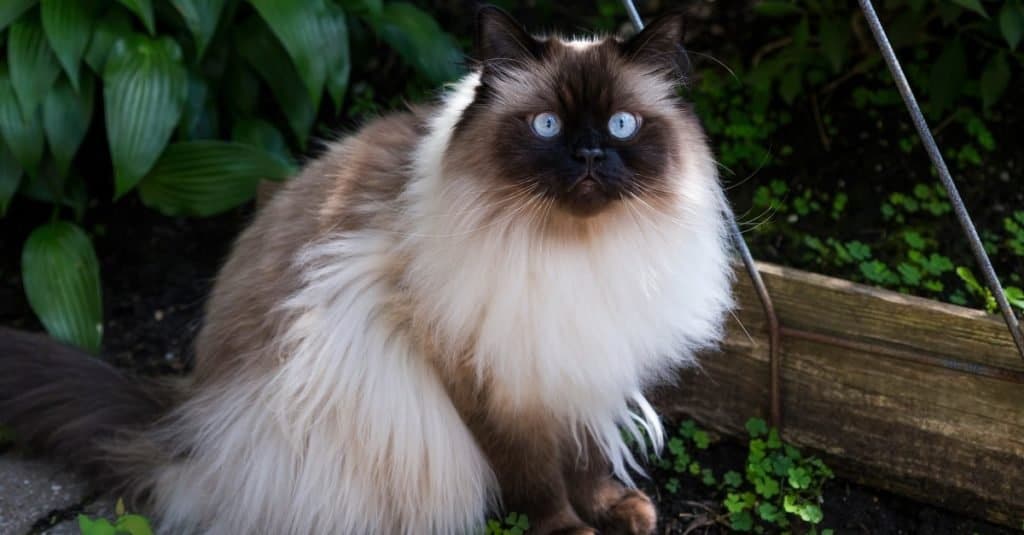
©Anne Richard/Shutterstock.com
Price
The cost of Himalayan cats ranges from $200 to $2,500 depending on many different factors.
You can find Himalayan cats from reputable breeders starting at about $1,000. Some of these are kittens who make great pets but will not do well in a show arena. If you are interested in showing Himalayan cats, then you can expect to pay more. There are about one or two breeders in each state, with many having over 20 years of experience in raising this breed.
If you are looking for an adult show cat, then keep in mind that their previous winnings and the winnings of their parents can affect the price.
Remember that the initial cost is only the starting price. You will have to pay the cost of food, vet bills, toys, and treats.
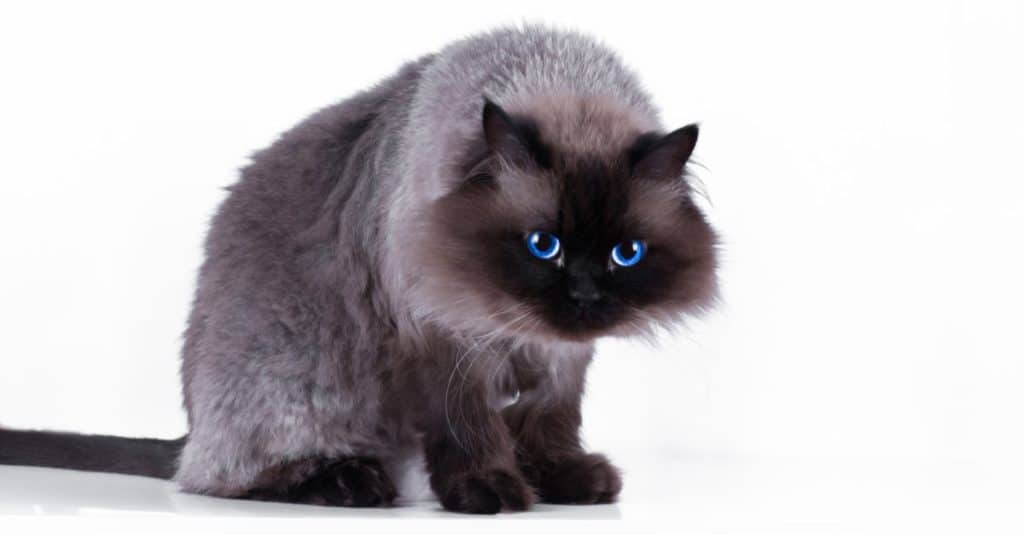
©Maslouskaya Alena/Shutterstock.com
Kittens
If you consider a Himalayan kitten, do not be surprised if it is hard to spot their points. They are not visible at all when the kitten is first born. The first hint of points will appear when the kitten is a couple of years old, but they will not be fully apparent until it is 12-to-18 months old.
Himalayan cats usually have liters of three-to-six kittens. Each should be born with blue eyes and pink nose. These felines are usually about average size. Instead of being born bigger than other breeds that they eventually outgrow, it takes the Himalayan longer to mature.
Expect Himalayans to have a smaller litter if it is their first litter. Litter size usually increases with experienced moms.
Himalayan kittens are great around children. One breeder of 20 years in California talks about how she often visited her grandparents in Iowa during summer vacations. She was about seven when a mother Himalayan, decided to give birth on her lap. It was at that moment she knew that she wanted to be a breeder.

©Yulia Kupeli/Shutterstock.com
Lifespan
The Himalayan breed was developed from the Persian and Siamese cat breeds. Both of these breeds are among the longest-living cats. On average, the Persians live 15 to 20 years. The Persian may develop some stomach issues as it ages, which can also be true of the Himalayan. The Siamese breed also lives to be between 15 and 20 years old. Therefore, it should be no surprise that the Himalayan is one of the longest-living cat breeds.
While breed stands call for a smashed face without an extended nose, this can lead to respiratory issues in some Himalayans. Their unique chubby faces are also more suspectable to cherry eyes and dental problems, which can become tougher to manage as the cat ages.

©iStock.com/Louis-Michel DESERT
Breed Vs. Mixed
If a Himalayan cat does not have points, then it may be a mixed breed. These points are darker colors around the ears, facial mask, legs, paws, and tail. They should also have the paw and nose pad color that goes with their coloring.
All Himalayan cats have blue eyes. If the cat has eyes of a different color, then you can suspect that they are a mixed breed.
The Himalayan cat is a long-haired cat. In fact, in 2014, Colonel Meow was named the cat with the longest hair by the people at Guinness World Records. His hair measured 9 inches long. While not every cat will rival Colonel Meow for hair length, if the cat does not have long hair, it is not a purebred Himalayan.
Himalayan cats also have a double coat. There are short hairs under the long ones. If you let the cat go a couple of days without brushing it and do not find a matted undercoat, it is probably a mixed-breed cat.
If the animal is grey, then it is a mixed breed. There is no such thing as a grey Himalayan. Therefore, the grey color is a dead giveaway that it is not a pedigreed Himalayan.

Types of Himalayan Cats and Colors
Various organizations recognize many different colors of Himalayan cats. When the Cat Fanciers of America first approved the breed in 1959, they approved three-point colors, and they remain popular today. They are:
- Seal – Deep seal brown points, nose leather, and paw pads on a pale fawn-to-white-colored cat
- Blue – Blue points on a bluish-white cat with slate blue nose leather and paw pads
- Chocolate – Milk chocolate points on an ivory-colored cat with cinnamon pink nose leather and paw pads
Then, the association added flame and torte points in 1964. Flame points are deep orange flame to deep red points on creamy white cats. These white cats should have coral-pink nose leather and paw pads. Cats who have torte points should be seal with undisturbed patches of red or cream. This is one of the few color combinations where cats can have coral pink or seal brown nose leather and paw pads.
The color choices expanded again in 1972 with blue creams, which feature blue with patches of cream, and again in 1979 with the addition of creams, which are buff white on a cream body. Since then, the organization has expanded to include many different point colors. Other example points are Tabby, Lynx, or Tortoiseshell-patterned.
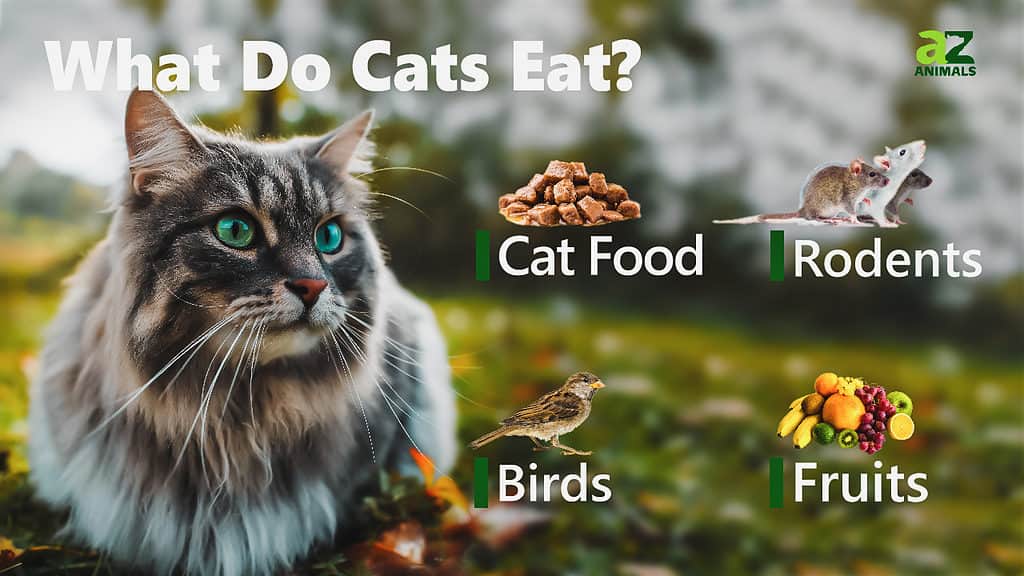
What to Feed a Himalayan Cat
- Combat hairballs
- Fiber comes from natural sources
- Grain-free
- Primary protein is from animal sources
We are probably all in agreement that Himalayan cats are simply beautiful, and one of the characteristics that enhances their beauty is their long, soft coat. For pet owners, this is a factor to take into consideration when deciding on what food to give them. Himalayans will be more prone to hairballs, which can hamper their digestion. The best kind of food would be one that helps them digest the hair and pass it through their systems without issues.
We’d recommend a food such as Blue Buffalo Wilderness Indoor Hairball and Weight Control formula, which will not only help your cat pass hairballs–it’s a high fiber, grain-free food that will also help your cat maintain a healthy weight.
View all 104 animals that start with HHimalayan FAQs (Frequently Asked Questions)
Are Himalayans herbivores, carnivores, or omnivores?
Himalayans are Omnivores, meaning they eat both plants and other animals.
What Kingdom do Himalayans belong to?
Himalayans belong to the Kingdom Animalia.
What phylum to Himalayans belong to?
Himalayans belong to the phylum Chordata.
What class do Himalayans belong to?
Himalayans belong to the class Mammalia.
What family do Himalayans belong to?
Himalayans belong to the family Felidae.
What order do Himalayans belong to?
Himalayans belong to the order Carnivora.
What type of covering do Himalayans have?
Himalayans are covered in hair.
What genus do Himalayans belong to?
Himalayans belong to the genus Felis.
How many babies do Himalayans have?
The average number of babies a Himalayan has is 4.
What is an interesting fact about Himalayans?
The Himalayan is also known as the Colourpoint Persian!
What is the scientific name for the Himalayan?
The scientific name for the Himalayan is Felis catus.
Thank you for reading! Have some feedback for us? Contact the AZ Animals editorial team.
Sources
- ASPCA Pet Insurance, Available here: https://www.aspcapetinsurance.com/resources/himalayan-cat-facts/#:~:text=Adults%20grow%20to%20be%207,as%20a%20term%20of%20endearment.)
- The Pets And Love, Available here: https://www.thepetsandlove.com/are-himalayan-cats-hypoallergenic
- FAQ Cats, Available here: https://faqcats.com/how-much-does-a-himalayan-cat-cost/
- Tica, Available here: https://tica.org/breeds/browse-all-breeds?view=article&id=1444:the-himalayan-breed&catid=48
- Persian Cat Corner, Available here: https://persiancatcorner.com/how-big-do-persian-cats-get/
- Purr Craze, Available here: https://purrcraze.com/when-do-persian-cats-stop-growing#:~:text=1%20to%202%20years%3A%20While,and%20skeletal%20structure%20grows%20fully
- Purr Pals, Available here: http://www.purrpals.info/index.php/av3
- The Cat Fanciers Association, Available here: https://cfa.org/persian/himalayan-persian-article-1999/





